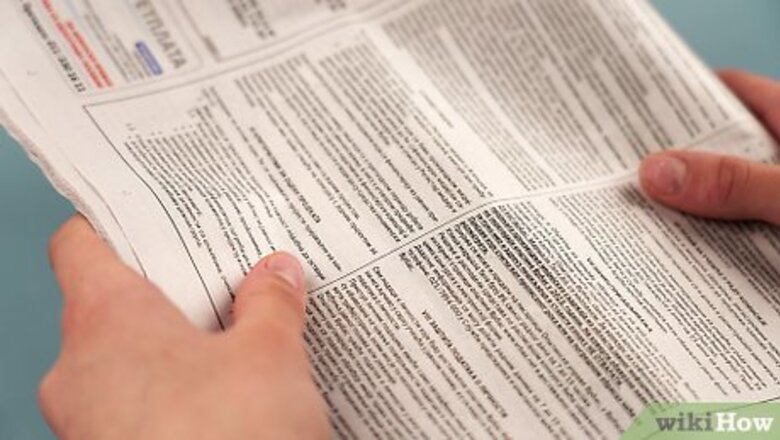
views
- Stuff your shoes with wadded up newspaper and let them sit for several hours, replacing wet pages as the shoes dry.
- Alternatively, hang your shoes in front of a fan for 2-3 hours to safely dry them.
- Put any fabric shoe (cotton, canvas, nylon, polyester) in the dryer for 25 minutes at a time on low heat until dry.
- Place damp shoes in a closed box of dry, uncooked rice for several hours until dry.
Newspaper

Grab a newspaper and discard pages with lots of dark or colorful ink. Try to use pages with the most “white space” on them, like ones without photos or large titles that concentrate lots of ink in one spot. Pages with pictures, for example, could leak ink onto white or light colored shoes (especially since they’re wet). If you notice small ink spots on leather shoes once they’re dry, buff them out with a cotton pad dipped in isopropyl alcohol (just don’t use it on the soles). Newspaper is safe to use on any shoe type or material. It will also prevent an odor from forming by absorbing bacteria.
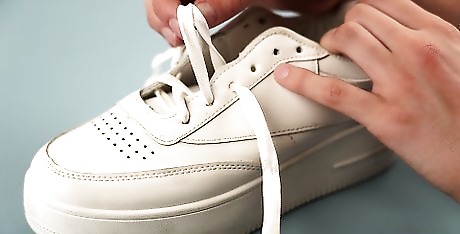
Remove the insoles and laces from the shoes and set them out to dry. Once the shoes are clean, unlace them and pull out the insoles (if possible), then place them in a well-ventilated spot away from direct sunlight to dry. Consider hanging your shoelaces on a drying rack or shower curtain rod like you would with wet clothes. Direct sunlight will dry your shoes quickly, but may cause the color and material to fade faster than with normal wear and tear. If you want to clean your shoes while they’re already wet, wipe away dirt or mud with a damp cloth or an old toothbrush with a bit of dish soap.
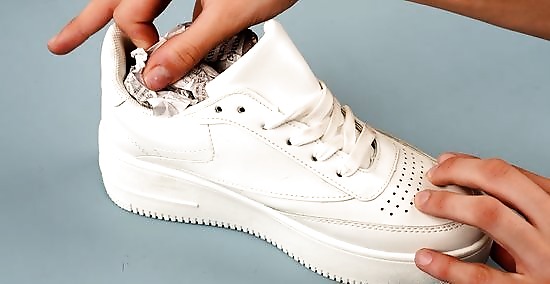
Ball up newspaper pages and stuff them into the toes of the shoes. Push the crumpled paper as far into the toe as you can, and keep adding paper until the insole is covered and the shoe is full. Depending on your shoe size, 2 large pieces of newspaper may be enough to fill one shoe.
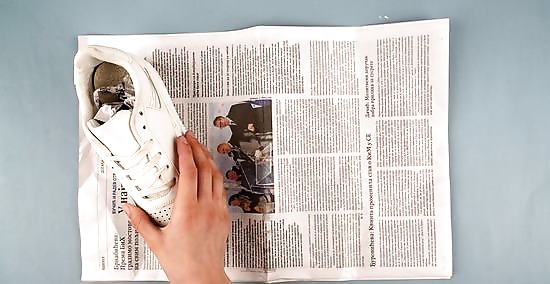
Wrap the shoes in newspaper pages or a dry cloth or towel. If you’re using newspaper, make a sheet that’s 2-3 layers of paper thick. Then, wrap your papers or towels around each shoe individually as tightly as possible to absorb even more moisture. Secure the newspapers or towels with rubber bands.

Place the wrapped shoes in a well-ventilated area to dry out. Try a table top or countertop in a room with a fan going or with the windows open, or even outside in the shade if it’s a breezy day. Stay away from areas that may be cold or damp like basements or bathrooms.

Check and replace wet pages every 2-3 hours until the shoes dry. Remove pages that are wet to the touch and replace them with fresh, dry ones to speed up drying time (letting damp pages sit in your shoes will slow things down). The total drying time could last 30 minutes, several hours, or even overnight. The wetter your shoes, the longer they’ll take to dry. The drying time is also affected by the material, humidity, and how much paper you stuff in them. Try adding a few drops of your favorite essential oil to one of your last rounds of newspaper to give your shoes a fresh, clean scent. Once the shoes are dry, you’re ready to replace the insoles and laces so you can hit the pavement!
Clothes Dryer
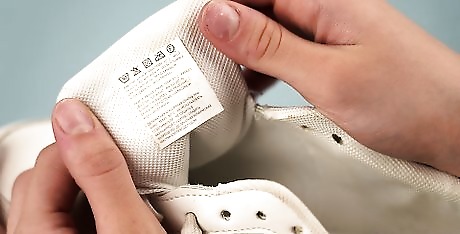
Check the care instructions on the shoe label to see if they’re dryer-safe. Look inside the tongue or heel for the instructions. If you see a square symbol with a circle inside, you can dry the shoes in the dryer. A square with a dot means they can go in with low heat only, and a square with an “X” means they should not go in the dryer. If there is no label or it’s faded away, assume the shoes are not dryer-safe and use a different method to dry them. Any fabric shoe (like cotton, canvas, polyester, or nylon) are safe for the dryer unless they have hard or gel heels, soles, or decorations. Suede, foam, gel, leather, lace, or shoes with glued-on decorations (like appliques, gemstones, rhinestones, or glitter) should never be machine dried. Do not put high-quality running shoes in the dryer. The heat can damage the gels, foams, and adhesives in the shoes.
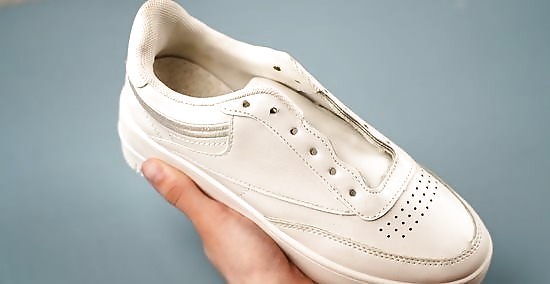
Partially untie the shoelaces and remove the insoles. Leave the shoes partially laced so you have long stretches of shoe laces to work with (just a few rows of eyelets should be laced up near the toe of the shoe). If your insoles are removable, take them out and set them aside to air dry. Remove any gel or foam inserts, as these materials can’t go in the dryer. Optionally, use a damp cloth or a small cleaning brush with dish soap to clean any mud or dirt off your shoes since they’re already wet.

Fill your shoes with rags, t-shirts, or socks to absorb moisture faster. These materials will cut down your drying time, plus they’ll help prevent fabric shoes from shrinking or changing shape in the dryer. Throw some towels and t-shirts into the dryer, too. These will absorb some moisture and dull the noise in case your shoes come loose and start tumbling around. To cut the drying time even more, empty your dryer’s lint trap before you put the shoes inside.
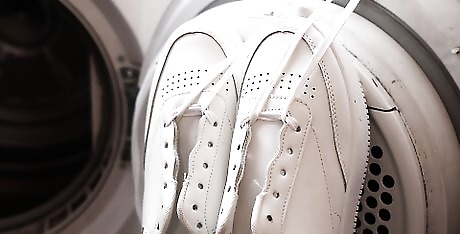
Hang your shoes inside the dryer by closing the door over the laces. First, tie a double knot with the 4 ends of the shoelaces. Then, open the dryer door and hold your shoes by the laces so that the soles are pressed against the inside of the dryer door. Close the door over the laces so the double knot hangs outside the dryer. The laces will suspend the shoes and stop them from banging around. If your dryer has a stationary drying rack, simply put the rack in the dryer and place your shoes on top. Select the appropriate setting for stationary drying. If you don’t have a dryer rack and your shoes don’t have laces, put them in a mesh laundry bag and place them in the dryer like regular clothes.

Run the dryer in 20-minute intervals on low heat until the shoes are dry. Use an air dry setting if your machine has one. If not, choose the lowest temperature to minimize possible shrinkage, heat damage, or wear and tear. To check the shoes, stop the machine and then grab the part of the laces hanging outside the door before opening the door. If the shoes are still damp, run them for another 20 minutes and check them again.
Fan
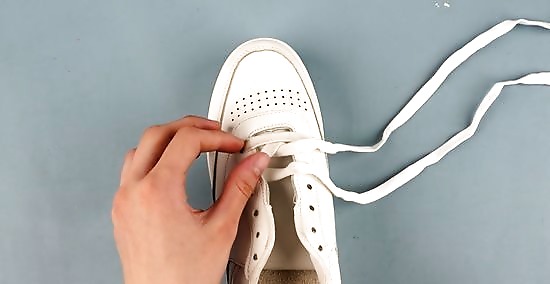
Remove the laces and insoles and set them aside to air dry. If they’re removable, lay the insoles flat in a well-ventilated spot out of direct sunlight. Lay the shoelaces next to the insoles, or hang them up somewhere they won’t get tangled, like a clothes drying rack or over a shower curtain rod. Use the fan on any type of shoe or material, especially leather, suede, or other materials that can’t go in the dryer. If you want to clean up your shoes while they’re already wet, remove mud or dirt with a damp cloth or a small brush and dish soap.
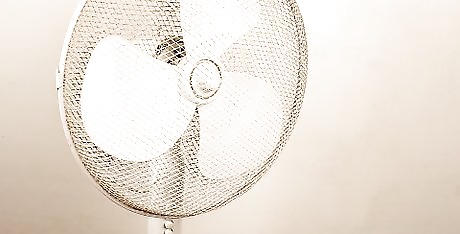
Grab a sturdy fan that’s taller than the length of your shoes. Use a box fan or something similar that’s strong enough to stand upright with the weight of your shoes hanging from it. The bigger, the better. Set up the fan in a space where the noise and breeze won’t bother you and lay a towel underneath it to catch water that drips from your shoes. If you don’t have a fan, lay your shoes in front of the vent on your refrigerator (usually found beneath the fridge door). During cooling cycles, the vent blows warm, dry air.
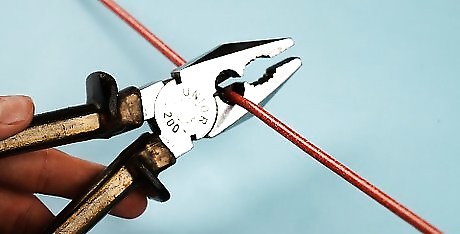
Cut two 6 in (15 cm) lengths of wire from a clothes hanger. Use a wire cutter to snip your hanger segments. Wear a pair of thick, protective gloves just in case the hanger or wire cutter slips while you cut.
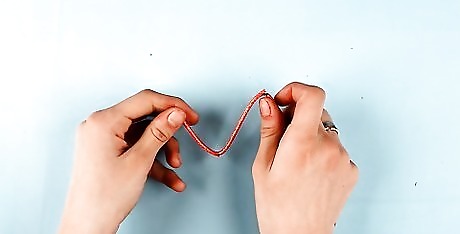
Bend each length of wire into an “S” shape. Use your hands to bend hooks at each end of the wire—one smaller hook to hang on the fan, and one larger hook to slip inside your shoe. If the wire is too hard to bend by hand, use a pair of pliers to help you.
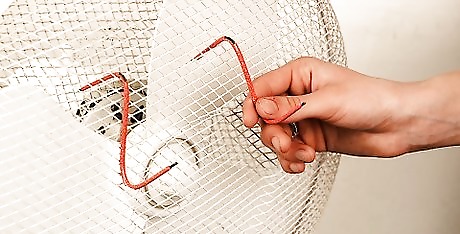
Hang the small hooked ends of each wire on the front of the fan. Leave about 9 in (23 cm) between the 2 wires so there’s plenty of room for air to flow between and around the shoes.

Open up each shoe and hang them on the large hooks of each wire. Pull up the tongue of the shoes so they’re open as wide as possible (this helps air flow inside them and dry them faster). Hang them from the inside heel so the openings of the shoes are facing the fan blades.
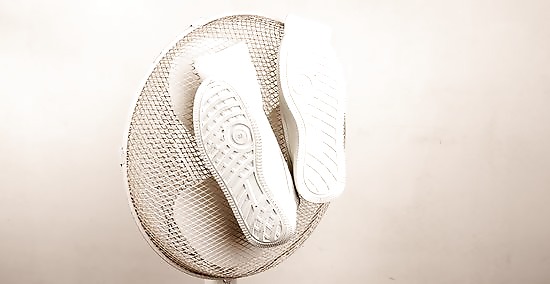
Set the fan to medium or high and let it run for 2-3 hours. Keep the fan running until the shoes are dried completely (inside and outside). Once they’re dry, replace the insoles and laces. Then, you’re ready to hit the town!
Box of Rice
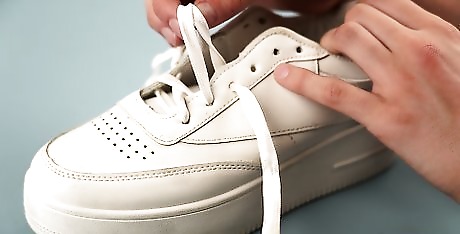
Remove the laces and insoles to air dry separately. After the shoes are clean, set the laces and insoles in a well-ventilated spot to dry out (since they’re smaller than the shoes, this won’t take very long). Alternatively, if there’s enough room in your box, lay the insoles and laces in the rice alongside your shoes. Use rice safely on any type of shoe or material, especially large boots, suede, leather, or anything that’s unsafe to go in the dryer. If you like, take a moment to clean up your shoes while they’re already wet. Rub away dirt and mud with a damp cloth or an old toothbrush with some dish soap.
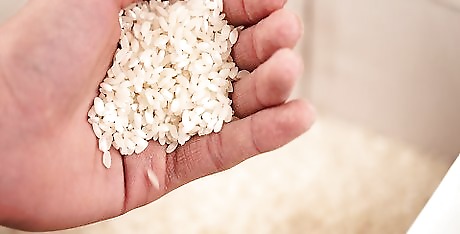
Cover the bottom of a box with about 1 in (2.5 cm) of uncooked rice. Use a cardboard box, like a shoe box, or a plastic storage bin that has a lid and is big enough to hold the pair of shoes. Make sure it has a lid so that the rice can absorb moisture from the shoe more effectively. Alternatively, use fresh cat litter instead of rice.
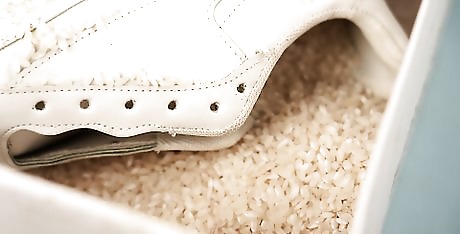
Place your shoes open-side down in the box and cover them with rice. Dredge the shoes (and especially boots) through the rice first to get some grains inside for thorough drying. Then, lay them open-side down (or whichever way they’ll fit if you’re drying large boots). Pour extra rice on top of them until they’re covered.
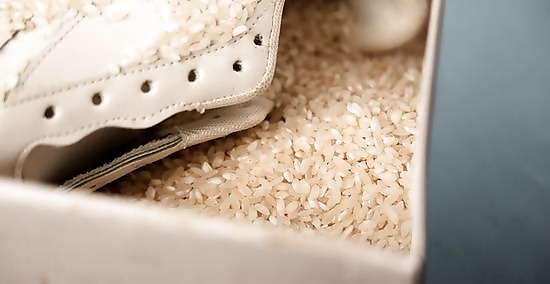
Close the box tightly and check the shoes in 2 hours. Let the box sit still for several hours while the rice grains absorb moisture from the shoes. Check them after 2 hours—if they’re still damp, let them sit longer (even overnight if needed). If the rice grains look bigger or feel damp but the shoes are still wet, the rice may be saturated. Dump the rice and fill the box again with fresh, dry grains.
Shoe or Boot Dryer

Pat your shoes or boots as dry as possible with a cloth or paper towels. Remove as much moisture from the insides and outsides of your shoes as you can to speed up drying time. This also helps prevent dripping, which is good since most boot dryers are electric.
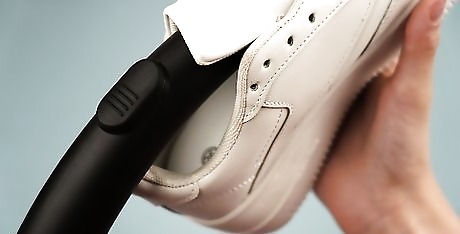
Place your shoes or boots on the boot dryer and turn it on. Lower your shoe or boot upside down onto one of the tall, thin towers connected to the base of the machine. Then, all you have to do is start the boot dryer and wait for it to work its magic! Some boot dryers force hot air to circulate through your boots, while others simply heat up the towers to dry them through convection.
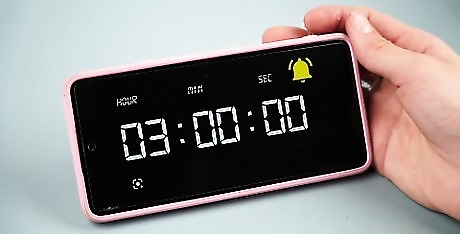
Check your boots in about 3 hours. Most boot dryers have timers to avoid overheating or starting a fire. The length of the timer varies, but usually goes no longer than 3 hours. If your boots are still damp, leave them on the dryer to continue air drying, or wait for the machine to cool down before starting it again.

Apply leather cream to your boots or shoes if needed. The heat from a boot dryer can make leather stiff and hard, so rub a thin layer of a moisturizing cream for leather onto your boots with a clean cloth. This will make them more comfortable and put the spring back in their step.



















Comments
0 comment